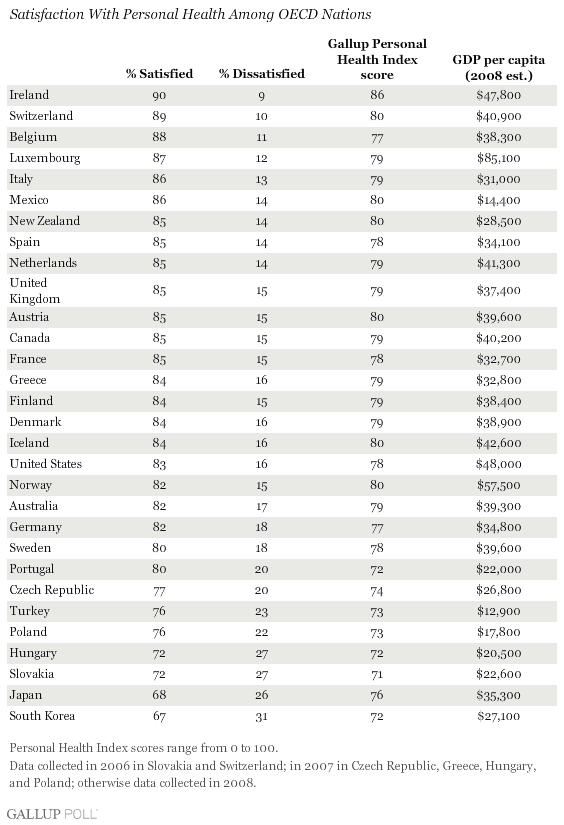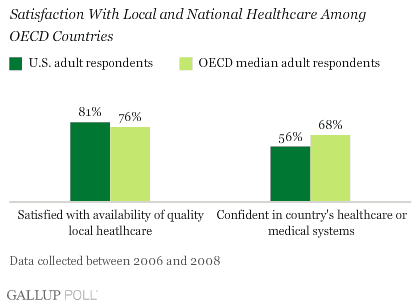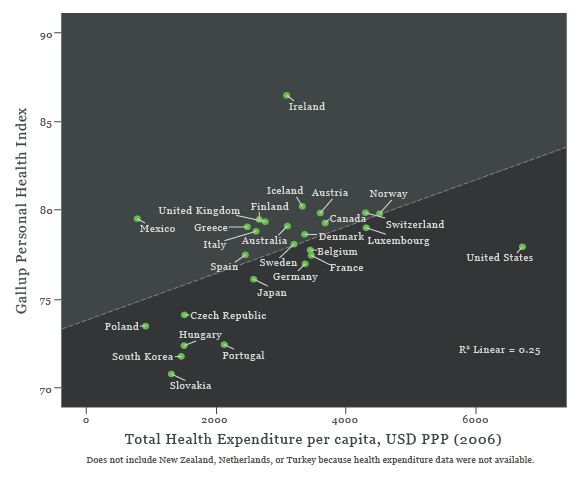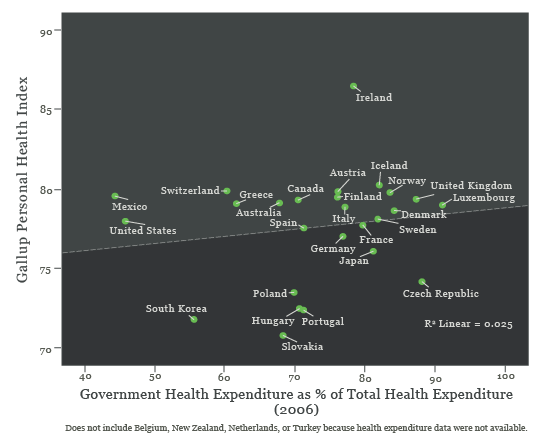WASHINGTON, D.C. -- Among the residents of all 30 Organization for Economic Co-operation and Development (OECD) countries Gallup surveyed between 2006 and 2008, Americans' satisfaction with their personal health falls near the group median despite having one of organization's highest GDPs per capita.

In his first address to Congress, President Barack Obama stated, "We can no longer afford to put healthcare reform on hold." The American Recovery and Reinvestment Act (also known as the stimulus bill) includes an estimated $59 billion for healthcare investment in addition to the approximately $2 trillion in current total national healthcare spending.
Behind only Luxembourg and Norway, the United States maintains the third-highest GDP per capita ($48,000) of all OECD countries. However, the relative wealth of the U.S. economy does not necessarily translate into confidence in national healthcare systems. While Americans' satisfaction with the availability of quality local healthcare is high, surpassing the OECD median, confidence in their country's healthcare or medical systems as a whole falls well below the median.

Only 56% of American respondents say they have confidence in their country's healthcare system. Of the countries in the OECD, only five have significantly less confidence in their country's healthcare system than the United States: Poland, Greece, Slovakia, Ireland, and Hungary.
The Higher the Total Healthcare Spending, the Better People Feel
The disparity between how much the United States spends on healthcare and how satisfied people are with their personal health makes the country a unique case. While the United States has the highest per-capita total health expenditures of any country in the OECD, Americans report relatively average levels of perceived health, according to Gallup's Personal Health Index.
Gallup measures perceptions of one's own physical and mental health through the Personal Health Index. The index includes respondents' opinions of their own health status in addition to incidence of pain, worry, sadness, and rest. The aforementioned satisfaction with personal health question is included in the index calculation. Traditional assessments of health across countries usually involve public health statistics such as life expectancy, infant mortality, and disease infection rates. For example, a recent report from the Business Roundtable, an association of CEOs of leading U.S. companies, evaluated the relationship between healthcare spending in the United States and Americans' general health using traditional statistics such as these.
The Gallup Personal Health Index measures self-reported personal heath perceptions using the same personal health assessment questions in more than 140 countries. Among the OECD countries surveyed, the Personal Health Index correlates strongly with 2008 GDP per-capita estimates (0.55) and with the most recent United Nations Human Development Index (0.63).
Gallup compared the Personal Health Index scores across OECD nations with the total amount each country spends per capita on health expenditures (defined here as total consumption of healthcare goods and services plus capital investment in healthcare infrastructure, both public and private).
The United States, which spends by far the most among OECD members on health per capita ($6,714) and the most as a percentage of its GDP (more than 15%), has only a relatively average Personal Health Index score (78) compared with other OECD countries. Notice how the United States is an outlier on the following graph.

To compare, Ireland (which has a universal health system with universal coverage) spends half that amount per capita ($3,082) and has a Personal Health Index score of 86, the highest among all OECD countries Gallup measured. Notice how Ireland is a considerable outlier, as well. To note, 2006 health expenditure data were not available for the Netherlands, New Zealand, or Turkey.
Does It Help If the Government Picks Up More of the Healthcare Tab?
The Centers for Medicare and Medicaid Services (CMS) estimate that by 2018, total healthcare spending (government and private spending combined) will make up more than 20% of GDP (est. $4.4 trillion) in the United States. Yet CMS projects that growth in private healthcare spending, driven by the current economic recession, is expected to hit a 15-year low.
Thus, if private spending is projected to slow over the coming years, government spending (all tax-funded, government-sponsored expenditure) could account for an increasing percentage of total healthcare expenditure. The White House has also announced further investment in healthcare programs of more than $600 billion, slated over the next 10 years.
However, Gallup finds that, among OECD countries surveyed, no clear relationship exists between respondents' attitudes toward personal health and government spending as a percentage of total health expenditure. To note, the calculation for government health spending is different from the previous calculation for total health spending. Total health spending includes government and private spending combined. Government health spending is individually measured as a portion of total spending. For example, a country with universal healthcare coverage might have a higher portion of its total health expenditure provided by the government than a country without universal coverage.
The following graph illustrates that as the proportion of government-funded health spending increases, Personal Health Index scores do not increase substantially, with the exception of Ireland.

In Mexico and the United States, government spending on healthcare accounts for less than half of total healthcare spending. However, Personal Health Index scores in these countries are not substantially different from scores for Sweden, Denmark, or the United Kingdom, where government spending accounts for more than 80% of total healthcare expenditure.
Is U.S. Healthcare in the Emergency Room?
Finally, Gallup finds a clear relationship between GDP per capita and Personal Health Index scores in OECD countries. In most countries in this group, the higher per-capita GDP is within a country, the more positive respondents' attitudes are about their personal health. However, the United States stands outside and below this observed trend. Gallup also finds a positive relationship between total healthcare spending (including government and private spending) and perceptions of personal health, yet there is no clear relationship within the OECD between government spending as a portion of total spending and health perceptions. This means that, in countries where governments pick up a higher portion of the total healthcare tab, attitudes toward personal health are not significantly higher than in counties where the government picks up less of the tab.
In a scenario in which private healthcare spending is going down and government health spending is going up, U.S. policy-makers determined to improve Americans' personal health attitudes should emphasize investments that increase the quality and efficiency of healthcare systems against escalating costs.
Survey Methods
Results are based on telephone and face-to-face interviews with at least 1,000 adults in Australia, Austria, Belgium, Canada, Czech Republic, Denmark, France, Finland, Germany, Greece, Hungary, Iceland, Ireland, Italy, Japan, Luxembourg, Mexico, Netherlands, New Zealand, Norway, Poland, Portugal, Slovakia, South Korea, Spain, Sweden, Switzerland, Turkey, the United Kingdom, and the United States, aged 15 and older, conducted between 2006 and 2008. For results based on the total sample of national adults, one can say with 95% confidence that the maximum margin of sampling error ranges from ±3.1 to ±4.2 percentage points. The margin of error reflects the influence of data weighting. In addition to sampling error, question wording and practical difficulties in conducting surveys can introduce error or bias into the findings of public opinion polls.
